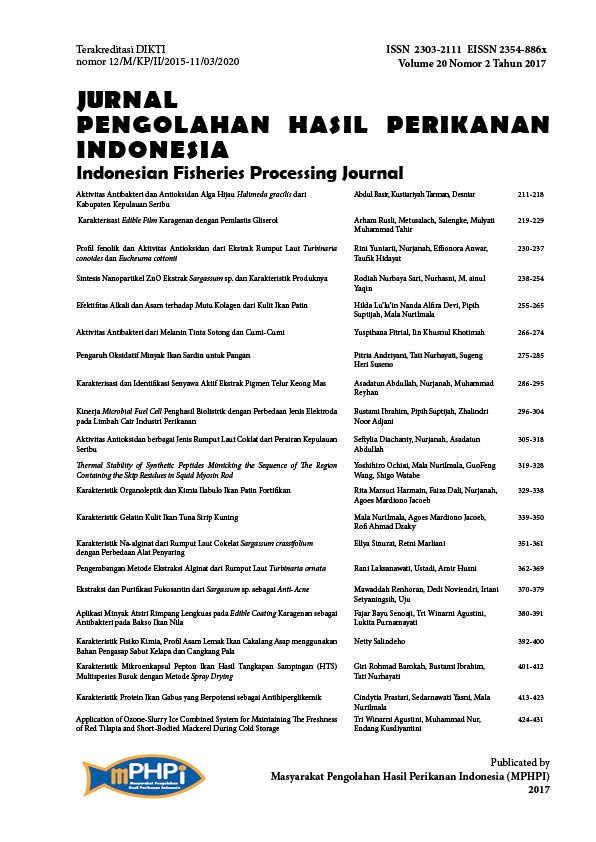Application of Essential Oils from Galanga Rhizome in Edible Coating Carrageenan as Antibacterial on Tilapia Fishball
Abstract
Fish ball is a perishable food product. One of an alternative method which could be applied to delay the deterioration process was using carrageenan edible coating with the addition of galangal rhizome’s essential oil as an antibacterial agent. The aim of this study was to find out whether the addition of carrageenan edible coating with galangal rhizome’s essential oil could increase the shelf life of the tilapia fish ball during cold storage or not. This study was used experimental laboratories with the completely randomized design used factorial (2x6) two factors include essential oils concentrations (0%, dan 1%) and storage time (0, 3, 6, 9, 12, 15) with three repetitions. The shelf life of the fish ball observed by sensory, TPC, TVBN, pH, Aw, moisture content, and gel strength test. The parametric data were analyzed by the ANOVA, while the non-parametric was using the Kruskal Wallis test. As the result, the fish ball with the 1% treatment was still acceptable until 15 days of storage compared with the control which only lasts for 9 days. The other results were the sensory test was 6.63≤π≤6.95, TPC value was 1.07x105 cfu/g, TVBN value was 30.33±1.68 mgN%, the moisture content was 61.38%±0.47, the Aw was 0.89±0.006, the pH was 6.24±0.0, and the gel strength was 721.19±1.61 g.cm. The treatment of 1% essential oil addition to carrageenan edible coating was significantly different (p<0.05) compared to the control treatment during cold storage to the characteristic of tilapia fish ball.
Authors
SenoajiF. B., AgustiniT. W., & PurnamayatiL. (2017). Application of Essential Oils from Galanga Rhizome in Edible Coating Carrageenan as Antibacterial on Tilapia Fishball. Jurnal Pengolahan Hasil Perikanan Indonesia, 20(2), 380-391. https://doi.org/10.17844/jphpi.v20i2.18106
Authors who publish with this journal agree to the following terms:
- Authors retain copyright and grant the journal right of first publication with the work simultaneously licensed under a Creative Commons Attribution License that allows others to share the work with an acknowledgement of the work's authorship and initial publication in this journal.
- Authors are able to enter into separate, additional contractual arrangements for the non-exclusive distribution of the journal's published version of the work (e.g., post it to an institutional repository or publish it in a book), with an acknowledgement of its initial publication in this journal.





